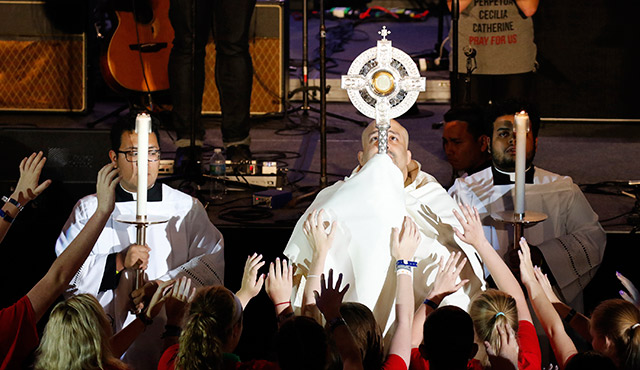During Mass, one of the most pivotal moments is the changing of bread into the body of Jesus Christ. There is silence as the Eucharist is raised and transformed into the Lord himself.
For many people, that moment is revered and expanded upon in the adoration of the Blessed Sacrament.
In Catholic churches throughout the nation, some form of adoration takes place, whether it is for an hour or 24 hours of being in the presence of Christ in the form of the Holy Eucharist.
“It’s a Eucharistic devotion,” said Fr. Troy Schneider, parochial vicar at Holy Family Cathedral in Orange. “The Blessed Sacrament is Jesus – the body, blood, soul and divinity. It is the Eucharistic species that is kept in the tabernacle. The Blessed Sacrament itself is THE sacrament above all sacraments.”
Christ as Eucharist is seen throughout scripture, with references to bread seen as significant and essential.
“From the Last Supper forward, we will recognize Him in the breaking of the bread,” Schneider said. “The belief and the teaching in our Church is that after the bread is consecrated it truly is Christ present. The Blessed Sacrament is not just the spiritual, but the real presence, a physical manifestation.”
The practice of displaying a Blessed Sacrament in a monstrance for the purpose of adoration is uniquely Catholic, Schneider said.
“The Orthodox usually consume everything at their religious rites; they don’t keep Jesus in a tabernacle,” he said. “There’s no other Christian tradition that I’m aware of that does that.”
Historically, deacons would take communion to those who were sick or were unable to come to the Eucharistic table. Later, the transferring of the Holy Eucharist between bishops was seen as a sign of unity.
In earlier days, a place of repose was developed for the Eucharist, where people would be able to sit in adoration in the presence of Christ. Some of the earliest tabernacles were shaped as doves or the Holy Spirit.
Today, parishes offer opportunities for adoration. Within the Orange County Diocese, about 80 percent of churches offer some form of adoration, usually for an hour or a 24-hour period on a regular basis.
At St. Vincent De Paul Catholic Church in Huntington Beach, adoration is offered from 9 a.m. Monday to 7 p.m. Thursday in the Blessed Sacrament chapel.
At Holy Family Cathedral in Orange, adoration is held on second Tuesday of each month, and from 7 to 8 p.m. every third Wednesday.
“A lot more parishes and a lot more people were finding that form of prayer – that adoration of the Blessed Sacrament – was becoming more fruitful toward our journey towards our Lord,” Schneider said. “It was more meaningful for them to spend some quiet time with our Lord amidst all the busyness of the world.”
About 10 percent of Orange County’s parishes offer 24-hour adoration seven days a week, including St. Martin De Porres Catholic Church in Yorba Linda, which offers it outside of its Sunday masses.
“That’s pretty good, considering that 24-hour adoration requires a person to be there at all times in the church, not only to monitor, but to be present when Jesus is exposed in the Blessed Sacrament,” Schneider said.
So groups such as the Knights of Columbus sign up to take the wee hours of the morning or the whole 24 hours, each person taking an hour-long shift. On one Wednesday a month at Holy Family, a youth group will sing praise and worship songs.
“It’s a community involvement,” Schneider said. “It’s not just one person doing it.”
And while there’s an actual ritual in how the Blessed Sacrament is exposed – with incense, prayers and a benediction – what one does in between the time can be different, Schneider said. Some will pray the Stations of the Cross, say rosaries, sing songs or read from scripture.
Some prayers will have a theme. In November, some pray for all the souls of the faithful departed. Others will pray for an increase in the priesthood and the consecrated life.
Schneider said he tries to encourage silent prayer during adoration.
“It’s probably one of the oldest forms of prayer because it comes all the way from the prophet Elijah – it’s that we find God in the silence,” he said. “It’s not in the storm or the earthquake. The silence came and Elijah recognized God. So prayer in front of the tabernacle or Blessed Sacrament in a monstrance is a time to offer that silence.”
Any form of prayer is a communication with God, Schneider said.
“And in any good communication you have to have somebody talking and somebody listening, and that’s no different with God,” he said. “And if we’re the only ones doing the talking though all of our prayers, sometimes we have to be quiet and let Him talk to us. In adoration, it’s an opportunity to be quiet and still our hearts. … When we’re quiet and rest our soul, we can open our hearts to what God is saying. It can be one of the deepest, most meaningful forms of prayer.”

